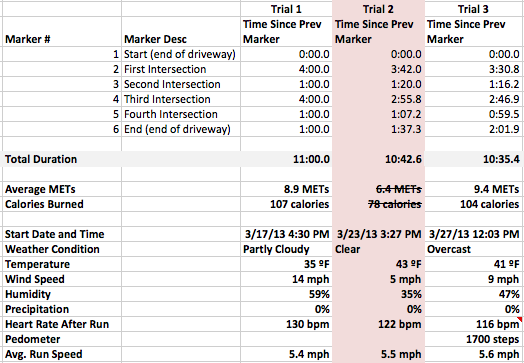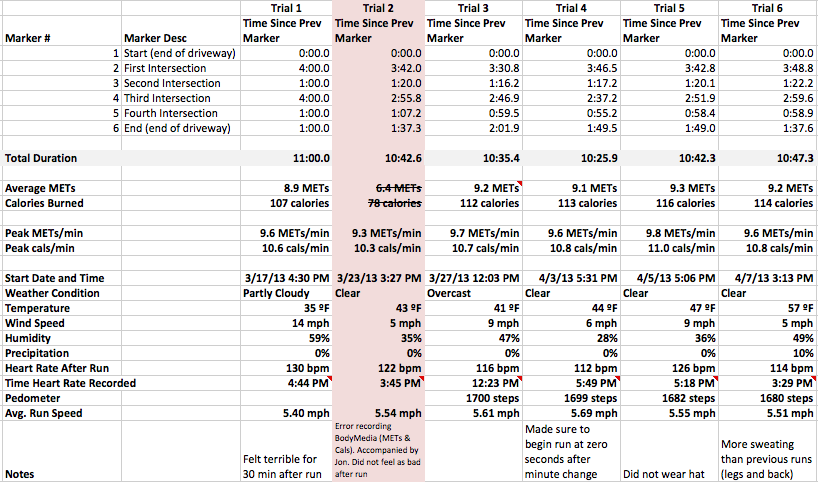Trial 3 of my Running Cold Experiment has brought with it some new insights. Each trial seems to help me rethink how to best capture the data I need. (Read Part 1 and Part 2).
I’ve decided that I am in an early phase where I am still defining the experiment. I will most likely need to throw out my first few data points as I continue to refine the process which should lead to better results. The alternative would be to lock in an inferior experimental method, which I think is far less desirable. That said, I am running out of cold days! So there is some time pressure to get it right.
New Metrics
I don’t yet know what all the factors are that may or may not have an effect on my runs. So for a while I am going to collect as many additional metrics as possible to help control for them. To that end, I discovered a new resource for weather data at wunderground.com.
I am hoping that once I have data from enough trials I will be able to account for things like wind speed and humidity by running some regression analyses, although I don’t currently know what is the minimum amount of data needed to do that with any sort of statistical rigor (I’ll research it once I’m closer).
I can say that qualitatively they have not had a noticeable effect, unless they contribute to making it feel warmer or colder than it actually is outside (likely). I haven’t noticed the wind much except in my latest Trial (Trial 3, today), between markers 2 and 4.
Data


Observations
It is proving harder than I thought to stay consistent with my run times. I started out too fast in Trial 3 and reached Marker 2 thirty seconds early. Then I slowed down to try to compensate, but ultimately ended up finishing 15 seconds faster than Trial 2, which was already faster than Trial 1. Under normal circumstances this would be encouraging as it indicates progress in terms of physical fitness, but in the context of this experiment I need to try harder to maintain consistency.
I suppose one way to look at it is to try to separate my exercise from my experiment. Another option would be to throw out Trial 1 and use Trial 3 as my new baseline. Right now it is far more appealing to just throw out my early data so that I am not constrained into the run time I established when I was less in shape. I will try to modify my runs to focus at a new target run time, which it may take me a few more runs to identify.
A Solution to Trial 2‘s Data Recording Problem: A New Metric
I have a Display Device that wirelessly communicates with my BodyMedia armband to give me real-time readings of steps taken and calorie burn. I don’t normally bother with it, but this time I took it with me and monitored the trip pedometer to make sure that the device was recording throughout my run. I don’t expect the metric to be very useful beyond ensuring the device is working since the approximate number of steps I take in the mile should not vary much, but I am a fan of collecting more data than I think I’ll need.
A Note about Heart Rate
I have been bad about recording my heart rate immediately after my run. So far I have been recording it at 6 or so minutes after I stop running but it varies, and it’s enough time for my heart rate to come down significantly before it is measured, so I am not confident in the consistency of this metric.
Part of this is because of limitations with the tool I am using (Azumio Instant Heart Rate): it doesn’t measure very well when my fingers are cold; there is even a warning to that effect in the app itself. The way it works is that I place my finger over my phone’s camera, which uses the flash to light up my finger and measure slight changes in the color in order to detect my pulse. I expect that my heart rate readings will become more accurate as the weather temperature increases and I am able to take the reading more immediately after my run, or if I move to a new tool like a heart rate monitor that goes around the chest.
Preliminary Correlation?
One interesting (possible) correlation I’ve noticed so far is that it appears that a longer run duration makes me burn more calories, even though this indicates that I ran faster in that period (because the distance is equal). This is evident in the following data:
| Trial # |
Calories Burned |
Run Duration |
| Trial 1 |
107 calories |
11 mins (and change) |
| Trial 3 |
104 calories |
10 mins, 35.4 seconds |
So if this is a true correlation, that would indicate if my goal were purely to maximize calorie burn, I would be better off doing longer endurance exercises than shorter high intensity exercises. That said, I can’t yet tease out what impact temperature or any of the other factors might also be having.
Once again, I have a fever and the only prescription is more data.
See Part 4 where I revise my methodology as a result of some good advice.






